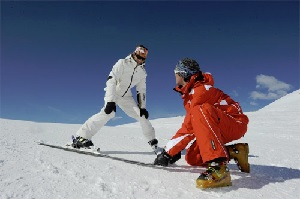How many times have you been on holiday and found that because you don’t know the language, you end up in embarrassing or frustrating situations. It’s a fault of many of the British but lack of knowledge of the language can also get you in trouble in the least expected places – for example, whilst skiing.
We don’t mean languages like French, Italian, German etc. but the language that describes the nuances of the sport, snowploughs, pistes, bindings, gondolas and more. If that’s got you worried about your first outing on the slopes, read on for a better understanding of the chatter you’ll hear on the piste and if you want to make yourself out to be a seasoned skier, try slipping a couple of the words or phrases into your conversations with those you share the slopes and the après-ski with.
First you need to know the type of skiing you’re doing. Generally it’s split into two varieties,
Nordic, which understandably developed in Scandinavia and is mainly concerned with cross country work and then there’s
alpine skiing – the one that’s best known to you and me.
What you’ll ski on is called the ‘
piste’ – not to be confused with the effects of après-ski. The alternative is off-piste but this is only for the brave, foolish or the skilled as your short skiing career could be painfully curtailed by rocks, trees, rivers and cliffs that inconveniently dot the previously unskied routes.

At ski school you’ll be encouraged to ‘
benz ze knees’ as it gives you a lower centre of gravity and hence more control. Early lessons will focus on just getting you to stay upright, stay where you are and when you’re ready to move, you’ll be taught immediately how to ‘
snowplough’ – effectively how to stop you moving! The snowplough involves keeping legs apart but toes turned in so the points of the skis almost touch but beware, if they cross you’re in trouble! You’ll need to turn your feet in at the same time to provide a cutting edge on the inside of the skis. First time skiers learn this very quickly as they are so frightened of moving, they’ll make sure they practise the art of stopping very hard.
We haven’t talked about equipment yet but apart from the obvious like ‘jacket’, ‘skis’ etc, all you’ll really need to know are ‘
bindings’ which sounds like strings or rope but is actually the clip mechanism that holds the ski onto your boot but also lets it go when you fall so you don’t twist a muscle, dislocate a knee or ankle or break a leg. Remember too that the trousers are called salopettes and most people look terrible in them with their inch or more of thermal padding (the salopettes that is, not the person!).
By the way if you ever find out the trick that some people manage of looking fabulous in ski gear, please let us know!
Finally whilst we’re on the subject of equipment, a little bit of useless information that might just help you come across as an expert – the little disk or ring at the bottom of the ski poles is called a
basket and it’s there to stop the pole going too deeply into the snow.
Now, the first major obstacle for the novice skier is which runs to head for (by the way a ‘
run’ is the name of the bit you’ll ski down, aka, the '
piste').
Black sounds bad and black runs are. Serious injury or worse faces the novice who unwittingly or otherwise heads for the black run.
Beginner’s runs are normally green but in Europe can be blue – take a look first before getting on your skis. Blue is the second level of difficulty then red. You might hear some people refer to or send beginners to the ’
bunny slope’ which is common lingo for where we all started one day. It gets its name for a variety of different reasons. Some say that first timers look like rabbits in the headlights when they get onto it. Others say the ski action is so slow and limited it doesn’t disturb the rabbits chewing the grass at the edge, whilst yet another story says it’s because the first timers look so cute, cute as bunnies! '
Nursery slope' is also widely used for the near flat 'bunny slope' and is pretty self explanatory as to why.
If you’re up early to ski, don’t be surprised if someone asks you if you’re doing the ‘
milk run’. This refers to the first skiing on the freshly prepared slopes that day – a little like a milkman being up and about early delivering the milk.
On the slopes you should be looking for the best '
powder' – not talcum or another name for stimulants, but the finest, driest, softest snow that is like skiing on your favourite duvet; even falling into it is heaven – a little like one of those slow motion adverts for fabric conditioner!
Get a little more confident and you’ll be '
carving' – cutting your own track through the virgin snow. Watch out for ‘
hardpack’ which usually means icy patches, difficult to negotiate safely and with no chance of carving! You may come across ‘
crust’ where the surface has thawed and refrozen but leaving the soft powder behind. It’s a tricky ski, often the precursor to a fall if the crust is thin and the base (depth of the snow) deep. Finally, your aim should be to make it safely to the ‘
run out’ where your ski run ends and either naturally, or through some judicial snowploughing, you’ll come to a hopefully elegant stop, ready to do it all again!
Watch out for our next ‘ski language’ lesson for cool dudes where we’ll talk brain buckets, freestyle, bombers and chatter!